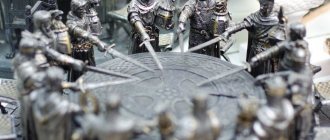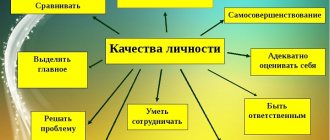.
It may seem that leadership is the same as the process of leadership itself, but if you look at the situation in detail, they are different things. The manager is responsible for ensuring that the company’s employees carry out everything efficiently and accurately according to his orders. The leader tries to direct employees to work in one or another area of activity. According to the manager, every employee of the enterprise should be interested in success, therefore he is obliged to work creatively, his impulses should benefit the enterprise. As practice shows, model 2 of behavior is much less common, although the effectiveness is higher.
Leadership theory
The most popular theory is that leaders are born, not made, that is, the theory of character, or “great man.” This refers to the innate inclinations and abilities of a person that help a person become a leader.
The second theory is situational. According to it, innate characteristics alone are not enough; certain conditions of the external world and the relationship between these conditions and a given individual are also needed. That is, the role is played by the extent to which the situation allows the leader to express himself.
Conclusion
Management and leadership are two different ways of organizing people. Leadership is about setting a new course or way of seeing for a group of people to follow. This means that the leader is the initiator of a new direction. When it comes to management, it involves controlling or directing the people/resources in a group according to the principles or values that have been previously established. A manager uses a formal, rational method, while a leader uses passion, attitude and emotion.
Leader Features
The most important feature of leaders is charisma. Read more about this in the article “Charisma: what is it in a person and how to develop it.” Other characteristics of a leader include:
- high level of aspirations;
- a high self-evaluation;
- self-esteem;
- self-awareness;
- adequate assessment of the strengths and weaknesses of one’s personality;
- the desire for success (importance and responsibility), recognition, power (managing people, directing them in a certain direction).
Of course, without certain competencies and abilities, a set of such qualities can give a completely different result. Therefore, other qualities of a leader include:
- above average intelligence, ability to solve complex and abstract problems;
- independence, resourcefulness, business activity, readiness for action, initiative;
- the ability to see the situation broadly, to consider beyond the particular;
- knowledge and experience in a specific field;
- good health, developed imagination, attention, memory, thinking;
- emotional balance and stress resistance;
- the ability to self-regulate (the ability to relieve stress);
- communication skills;
- ability for psychoanalysis;
- eloquence;
- visuality (external attractiveness).
Thus, all the qualities of a leader can be divided into general, specific, personal-business and psychological-pedagogical.
Story
In ancient times, leaders were often endowed with superpowers.
They had the gift of persuading and subduing . Generals, leaders, pharaohs were endowed with great intelligence and power given by the Higher Powers.
In 1517, Machiavelli wrote the treatise “The Prince” . This began the serious study of leadership and the advancement of various theories.
Fr. Galton proposed in 1869 the theory that leadership traits are innate
In the first half of the 20th century, serious study of the phenomenon of leadership began. It was believed that a leader must have a set of certain character traits.
These are mental, physical abilities, as well as the need for power, dominance, self-confidence and other personality traits.
Types of Leadership
Leadership can be emotional, business and informational.
Emotional
It arises on the basis of sympathy in the group between the participants and the leader. An emotional leader creates a favorable psychological climate, inspires trust, relieves tension, and instills confidence. This is the heart of the group. You can always contact him. As a rule, an emotional leader appears in informal groups.
Business
This type of leadership is found in formal teams. A business leader is distinguished by high competence, the ability to solve problems, and organize activities. These are the hands of the collective. A business leader builds relationships and communicates closely with management.
Informational
The information leader is the brain of the team. He is well versed in information flows and is highly erudite. People turn to the information leader for help and advice. He helps you search for information or answers questions himself.
The ideal option is a combination of all three types in one leader, but this rarely happens. More often there is a combination of a business leader and an emotional or informational one.
The direction of leadership can be:
- Constructive. Helps achieve organizational goals.
- Destructive. The leader's aspirations are detrimental to the organization.
- Neutral. Does not affect performance.
Types of Leadership
Among the types we can distinguish a leader, a leader in the narrow sense and a situational leader:
- The leader acts by suggestion. He is active, strong, physically developed, healthy, strives for success, self-confident, has the ability to adapt, is smart, has developed creativity and intuition, is tactful, sociable and easy to communicate.
- A leader has less authority than a leader. He also convinces and inspires, but he also motivates using the “do as I do” method.
- A situational leader emerges in a specific situation due to his strong abilities needed at the moment.
In relation to the attitude of the team to the leader, it is customary to distinguish the following types:
- "One of us". He does not stand out among the group in any way, but is perceived by her as first among equals.
- "The best of us." In almost all qualities he stands out from the group and acts as a model.
- "Good man". Valued and distinguished by the team for his moral qualities.
- "Servant." Considered as an intermediary, a representative of interests.
The same leader can be perceived differently by team members, that is, he belongs to several types at once. In general, there are leaders in any group, both official and unofficial, both destructive and constructive. For example, the example known to everyone since school was the prefects (formal leader) and hooligans (informal leader) of the class.
Leader and manager
Leadership is a formal position of a person that has nothing to do with his personal qualities, although they influence the leadership style. Leadership is a position occupied by a person due to his individual personal characteristics. Perhaps this is the main difference.
Among the similarities are the following:
- orientation to the goals of the organization;
- communication with people and groups of people;
- motivating employees and other influence on them;
- creating and maintaining a favorable psychological climate.
Sometimes a manager and a leader are considered synonymous if these roles coexist in one person. But this doesn't always happen. It is also possible for the leader to identify a leader or leaders of the group and identify informal leaders.
The leader is interested in and participates in the work process. He consults, gives advice, supports feedback and pushes people to independence, leads, and sets a personal example. The manager may not do this; he may not even know his subordinates personally. Leaders do not provide ready-made solutions; together with other team members, they develop creative and problem-solving thinking.
Leadership can be transferred from one person to another depending on what knowledge, abilities, skills, qualities and abilities are needed to solve the current problem.
The nature of the power of a manager and a leader differs. The leader is endowed with authority and status. The leader wins the favor of the group and motivates them to successfully complete tasks with his authority and charisma. The power of authority is many times stronger than the power of authority. But this same power is easier to lose, since it is based on respect for the very personality of the leader.
Thus, we can highlight the following differences between a leader and a manager:
- The manager organizes all activities; the leader is largely responsible for vertical psychological relationships.
- The leader is officially appointed immediately after the organization is created, the leader is nominated spontaneously through the relationships of group members.
- The leader manages all activities and external relations of the organization; the leader is responsible for communication, activities and the nature of relationships within the group.
- The leader controls and rules, the leader himself fulfills the norms of the organization.
- The manager focuses on the prescribed rights, the leader - on the moral and psychological norms that have arisen in the group.
- Leadership is more stable, leadership depends on the relationships and opinions of team members, as a result of which leadership is changeable.
Leadership is social influence, which is based on the principle of legal relations, distribution of roles, power, control and discipline. Leadership is a psychological influence based on perception, imitation, mutual understanding and suggestion. This is voluntary submission and free communication.
The leader is the top position in the legal social-role hierarchy. A leader is the top in the hierarchy of authority and prestige.
Behavior styles
It is often on the basis of behavioral style that a manager is distinguished from a leader. This behavior is usually determined by the individual qualities of a person, so it cannot be said that some of them are characterized by one style, and another by another.
Experts have identified 3 styles of managing a work team: authoritarian, democratic, liberal.
An authoritarian management style is typical for managers. This is constant strict control of the performed duties of employees and their punishment in case of certain problems. With an authoritarian management style, the individual qualities of the employee are not taken into account. It is considered as a robot needed in the company to perform certain functions. This management style is productive for the company. It is profitable and productive. Employees who do not feel needed sooner or later quit, thereby losing everything that has been earned over a long time.
Democratic style is characteristic of leaders. The opinion of even the most ordinary employees is taken into account, which is extremely important. The key decision on almost all issues is made by general voting. A leader using this strategy feels like an employee like other officials, regardless of status. The democrat always listens to the wishes of employees and does everything to make everyone feel comfortable working in such a company. This style is the most effective. Each employee sees that the leader understands, values and respects him. They try to repay him in kind, doing their work efficiently and striving for new heights. There is a friendly atmosphere in the team, employees communicate well with each other and are ready to help each other at any moment (on issues that directly relate to work).
The liberal style is characteristic of those managers who are not interested in the success of the company or the needs of employees. They shift management responsibilities to other employees, and they themselves do not even know who works for them. This is the most failed management style that leads a company to bankruptcy.
Features of a leader
As I already said, the best option is a combination of management and leadership in one person. The leader-manager does not order or put pressure on employees. He clearly explains to them the goals and leads them towards these goals. In addition, the leader-manager:
- Able to perceive and accept common needs and problems, and take responsibility for solving them.
- Able to organize joint activities: formulating tasks that are relevant for the entire team, creating conditions for their implementation, taking responsibility, taking into account the interests and capabilities of each participant, planning work taking into account these features, considering and recognizing opposing opinions, distributing responsibilities, motivating staff.
- He is distinguished by empathy, tactfulness, trust, ability to communicate, sensitivity: he will listen, help, share secrets, defend interests, resolve conflicts.
- Able to represent the entire team on his own behalf, express a common opinion, take initiatives to higher organizations to meet the needs of the team.
- Knows how to emotionally and psychologically influence, attract people without coercion or orders, convinces and encourages.
- He thinks positively, which instills self-confidence in the entire team.
In conclusion, I want to say that the mere presence of inclinations and leadership abilities does not guarantee anything. As we see, many qualities of a leader are acquired in the process of life. Abilities help to develop them better and faster.
Person-centered approach
The first developments of the personality traits approach appeared at the beginning of the 20th century, when certain qualities of the most effective managers were identified. According to this theory, the best managers should have such qualities as high intelligence, attractive appearance, common sense, initiative, honesty, education in psychology and economics, and self-confidence.
Another version of the qualities of a true leader is offered by Samuel M. Walton, owner of the Wal-Mart supermarket chain. This man topped the list of the world's richest people in 1985, according to Forbes magazine. He outlined his idea of leadership in the book “Made in America. How I Built Wal-Mart,” which lists the 10 most important commandments of a leader:
- Dedication;
- always share their profits with their employees;
- stimulate your employees not only financially;
- share your knowledge;
- value the activities of their employees and do not skimp on praise;
- to celebrate success, it may embarrass competitors;
- listen to the opinions of your employees;
- to stay ahead of your customers' expectations;
- to keep track of your expenses;
- swim against the tide and not repeat the mistakes of others.
Fulfilling all these requirements, according to Samuel M. Walton, will lead the company to success in the near future.
This was the first stage in the formation of personality theory of leadership, but in the 1940s, scientists continued to study the relationship between personality traits and leader success, but they did not reach a consensus on the specific set of qualities that make a great leader. As a result, in 1948, Stogdill presented a comprehensive review of leadership research in which he noted that the study of personality traits continued to produce conflicting results. He also highlighted a number of qualities inherent in leaders. According to him, such people are distinguished by high intelligence, thirst for knowledge, reliability, sense of responsibility, ability to act and socio-economic status. At the same time, Stogdill found that effective leaders exhibit different personality traits in different situations. He later came to the conclusion that one does not become a leader by birth, but it depends on the situation. Thus, Stogdill concludes that “the structure of a leader’s personal qualities must be related to the personal qualities, activities and tasks of his subordinates.











